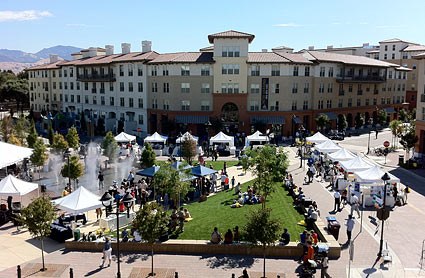I first became involved in the transit oriented development
movement in California in the late 1980s, when I was on the BART board of directors. At the time it was a
minor planning movement, with a small number of theorists, including Bob
Cervero and Peter Hall at UC Berkeley and Marlon Boarnet at UC Irvine, and
architects Peter Calthorpe, Dan Solomon, Robin Chiang, and Marc Futterman.
Over the next two decades, transit oriented development
entered the mainstream of planning theory
in California, with its own literature
and an array of federal, state and local
funding sources. The number of built projects always lagged behind the theory,
but a number slowly emerged.

During this time, transit-oriented development has been inappropriately used in California to justify
projects that have nothing to do with linking land use and transit. A high rise
is proposed in Los Angeles’ Century City, far from any existing rail system or
rapid-bus transit, and its proponents describe it as transit-oriented
development. Other downtown Los Angeles high rises and downtown San Francisco high rises that are not conceivably transit
villages receive state funds for transit-oriented development as they happen to be near heavy rail transit
stops.
Yet, there are a
number of transit villages that have been done right in California. My former
BART Board colleague, Dan Richard, last week reminded me of one, the Pleasant
Hill BART transit village. Dan is living now in Washington D.C., but he keeps
in close contact with his former district, including the Pleasant Hill project,
on which he played a major role.
The Pleasant Hill BART transit village actually dates back
to 1981, and was spearheaded by then Contra Costa Supervisor Sunne McPeak. At the time, the station area was surrounded
by open fields and scattered single family houses– with none of the
development linked to the station that had been predicted. A station area plan was undertaken by Sedway
Cooke, that set out high intensity uses within a 700-ft walking distance of the
station, tapering to lower densities farther from the station,.
By the early 1990s, a
good part of the plan was carried out, with 1600 residential units, 1.5 million
square feet of office space and a 249 Embassy Suites Hotel within a one-quarter
mile station radius. But there was a hole in the center, with the BART surface
parking lots covering 11.4 acres. BART issued an RFP in early 1995, and
initially chose an entertainment complex, with a 12 screen movie theatre. However, market forces and neighborhood
opposition led to a revised project that featured residential and neighborhood
serving retail. The project that emerged, and opened in October 2010, included 549
residential units (including 100 for-sale condominiums), 35,000 square feet of
neighborhood serving retail, and a 290,000 sq. ft. office building with a
20,000 sq. ft. business conference center.
As Dan and I discussed, Pleasant Hill holds a number of lessons
for transit village development in California going forward. Among these are
the need for a multi-year investment (Jim Kennedy of Contra Costa County was
involved for over 20 years),
public-private partnership involving the transit agency and municipality,
and mixes of uses with pedestrian and bicycle access to the station, to
encourage walking at the station.
Dan reminded me of
another major lesson: the value of neighborhood participation. Often
neighborhood opposition to a proposed
residential or commercial development in California is dismissed by project
proponents as NIMBY behavior. This dismissal long has struck me as wrong-headed,
since in California we should encourage residents to take ownership of their
neighborhoods . At Pleasant Hill, the
neighbors did take ownership, spend considerable time in the planning process
and helped mold it into a better project.

